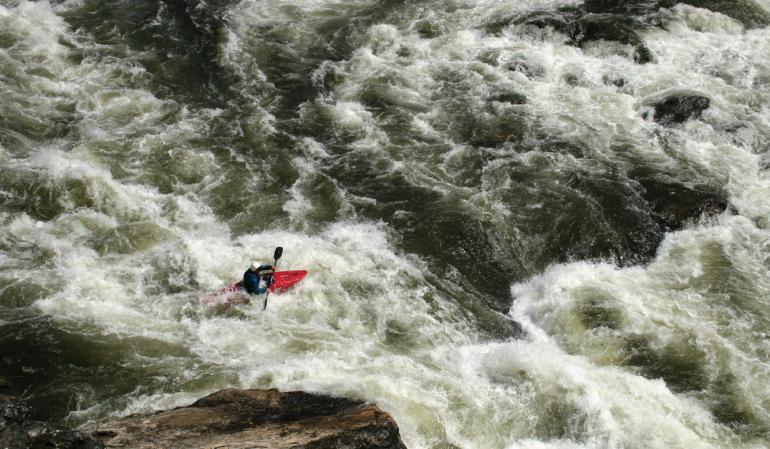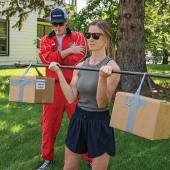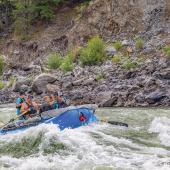To the Rescue
Swiftwater training in southwest Montana.
Arriving at Thumper Rapid on the upper Gallatin, our team spots an unconscious kayaker stranded on a rock in the middle of the whitewater. He’s in a section of river surrounded by strainers—dead trees lodged in the waterway. In any whitewater scenario, they can snag lifejackets, helmets, or body parts with their gnarled and spiky branches. In many cases, this leads to the paddler being pinned underneath and drowned.
First, we size up the scene, evaluating safe and effective ways for a river extraction. Because it’s my turn to lead the rescue, I head out first, wading through icy water toward the victim. He is unresponsive. I might be able to carry him back to shore, which is only about ten feet away, though the water is waist-deep and moving fast. But this is where the alarm sounds—the risks are too high. The possibility of being carried away and swimming through Thumper, or into a strainer, with an unconscious kayaker, is too real. I decide that I can get this victim to shore with the help of my fellow rescuers and begin CPR.
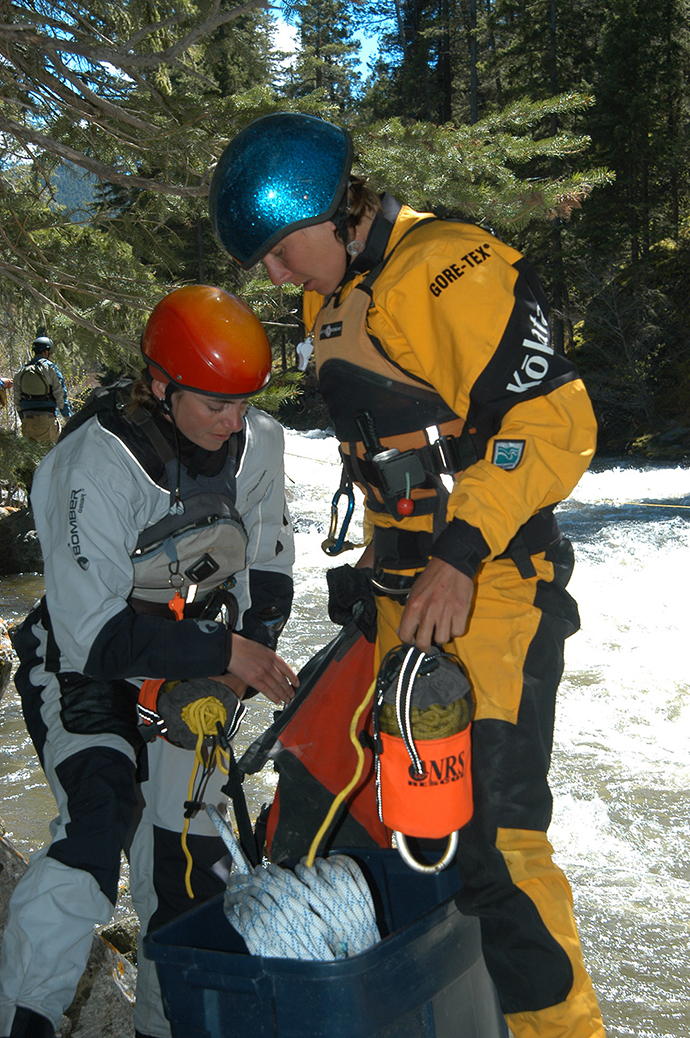
Preparing for the rescue.
I yell for a rope and one of my teammates pitches me a throw-bag from the shore. I connect one end of the rope to the ring on the back of my rescue vest and throw it back to him. This style of rescue is called “live bait." A practice where on-shore rescuers hold the rope harnessed to the back of the rescuer’s vest while the rescuer ventures out to the victim. The rescuer can release himself and the victim from the rope if necessary by unfastening a buckle on the front of the lifejacket.
I let my team know that I’m ready to begin, and carefully move the victim from his side to his back. I grasp the shoulders of his lifejacket and pull them into me while supporting his lower body with my legs. I shuffle us over to the side of the boulder, and with a tap of my head (the universal river sign for “ready” or “okay”), I slide into the water on my back with the victim’s head facing upward ontop of my abdomen, his legs supported by mine. The initial plunge into the icy water zaps my energy and immediately numbs my face.
A half second passes as we submerge into the rapid before the sudden jerk of the taut rope lifts us to the surface. We begin to pendulum toward shore with icy Gallatin water flowing over us, creating a tiny air pocket just big enough for both of us to breathe. I hold the victim’s head close, keeping his mouth out of the rushing water. We nudge onto the riverbank near my fellow rescuers, and they begin a controlled extraction from the river to administer medical care. The evac went perfectly.
Swiftwater Studies
Melting snow summons paddling enthusiasts in the spring, but high flows during runoff are as exciting as they are dangerous, and river traffic hits its peak. According to American Whitewater, whitewater caused 88 fatalities in North America last year—four of which were in Montana.
Respecting the river means understanding that an uncontrolled environment is just that—uncontrolled. Thankfully, there are ways for boating enthusiasts to reduce the risks, and one way comes in the form of swiftwater rescue training.
Learning how to approach whitewater rescue situations starts with experienced teachers. Cody Harris and Mike Johnston share 40 years of combined river experience, and work for the Whitewater Rescue Institute (WRI) as Director and Lead Instructor, respectively. Based out of Lolo, MT, WRI mostly teaches courses throughout the northwest, but occasionally teaches nationally and internationally. The organization is dedicated to creating river experiences through scenario-based approaches to whitewater emergencies. WRI stresses risk management through hands-on scenarios.
“WRI offers students more than a certification,” Harris says. “We offer over 40 years of combined experience in swiftwater education. Students walk away from our courses with more than knowledge.” He explains that by teaching through scenarios, graduates come away with a comprehensive understanding of what works and what doesn’t in swiftwater rescue.
The basic swiftwater course is a 24-hour, three-year certification that covers the foundations of self-rescue, hazard identification, and rescue techniques. With four hours of classroom time, the bulk of the course takes place on the river. The course is taught primarily through hands-on situations, offering an up-close and personal look at reading water, recognizing and avoiding hazards, quick-rescue techniques, boat-based rescues, and technical rescue systems. This course is perfect for river enthusiasts seeking more experience with rescue techniques and offers invaluable knowledge, such as effective communication, entrapment and extrication, mechanical advantage, and self-rescue.
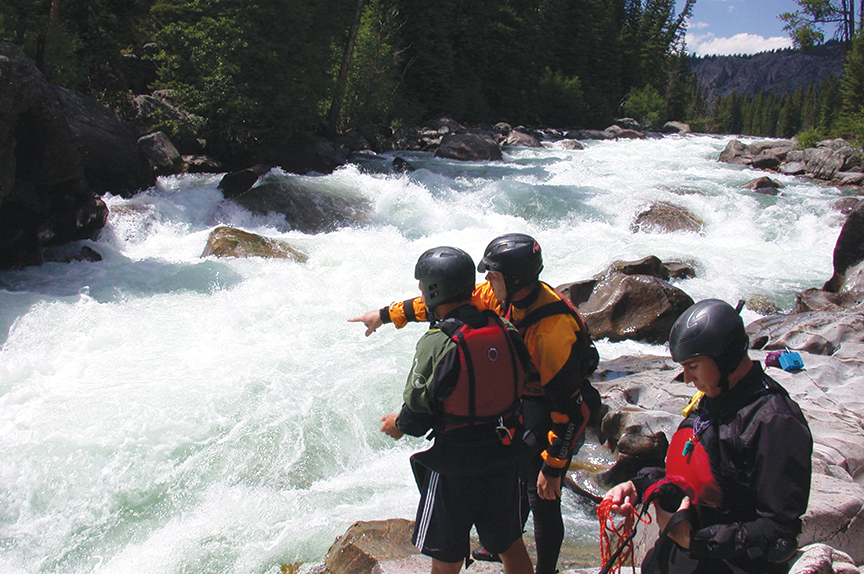
Clear communication is essential.
Water Test
During the course, Harris and Johnston leave us with our fellow rescuers and head upstream to stage a scenario. We drive up to the scene of the accident and identify the safest, most effective way to get the victims out of the river, into proper medical care. The majority of our time is spent on slippery shorelines, in ice-cold water, and working with ropes and rescue equipment.
This inherent risk is where the most learning happens—WRI teaches through realistic scenarios that simulate real rescue environments. You may have to rescue a panicked patient (or several) in the middle of the river, or the patient may be unconscious. To complete the basic course effectively, you must be able to demonstrate defensive and aggressive swimming techniques, throw-bagging, live-bait, z-drags, and show an understanding and awareness of rescue situations.
The basic course is a prerequisite for the advanced class, which is a three-day, 24-hour course that covers larger, more adverse and dangerous rescue scenarios. It covers patient care and transport, Class IV and V rescues, Tefler lowers, highline Tyroleans (if you don’t know what these are, you’ll have to take the course and find out) and advanced search skills. As the season approaches, do yourself a favor and sign up for one of their courses—you’ll be glad you did.
For information on course dates and locations, visit whitewaterrescue.com.

